8 Flowers That Don’t Attract Bees (With Pictures)
-
Pete Ortiz
- Last updated:

There are a number of reasons why someone might not want bees in their garden. Some people are deathly afraid of bees. Some gardeners have been stung one too many times by bees to want them around. Some people are deathly allergic to bees, where a single sting can lead to a trip to the hospital. Whatever the reason for wanting to avoid bees, there are numerous plants that will help you achieve your goal. You do not have to have a barren garden in order to keep bees away. You can plant beautiful flowers and aromatic plants that are amazing to look at but won’t attract any bees.
Here are 8 amazing flowers that will not attract bees to your garden.
The 8 Flowers That Don’t Attract Bees
1. Rose Flower
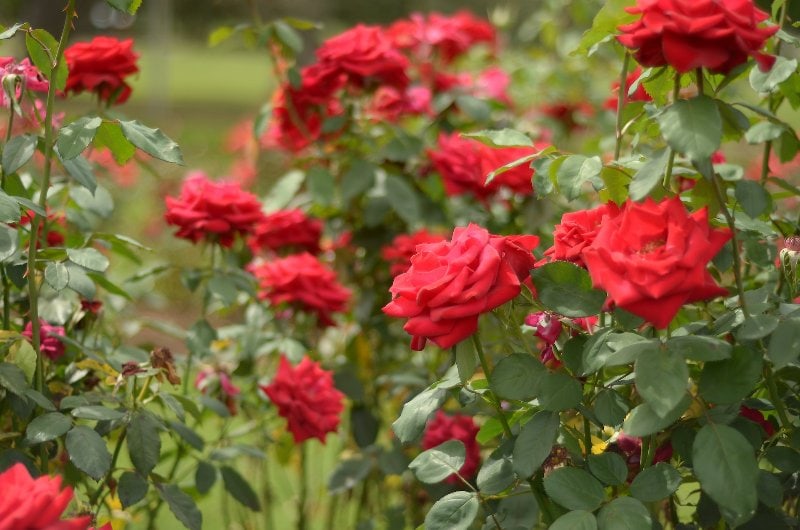
| Scientific Name: | Rosa |
| Type: | Woody flowering perennial |
Surprisingly, roses are unappealing to bees. Roses are some of the most iconic flowers in the world, and they are known for their complex blooms and their thorns. However, roses offer almost nothing to bees. That means planting roses will give you a beautiful plant to adore without the risk of attracting the pesky stinging insect.
There are hundreds of different varieties of roses, and some are more repellent to bees than others. You can plant unscented varieties of rose that offer nothing scrumptious for bees to latch onto. Finding roses with a rich red color or a white color will also help keep bees away. Bees will be more attracted to pink roses or off-color roses. Traditional red and white roses have colors that bees cannot see very well, which will keep them from honing in on your beloved flowers.
2. Marigolds Flower
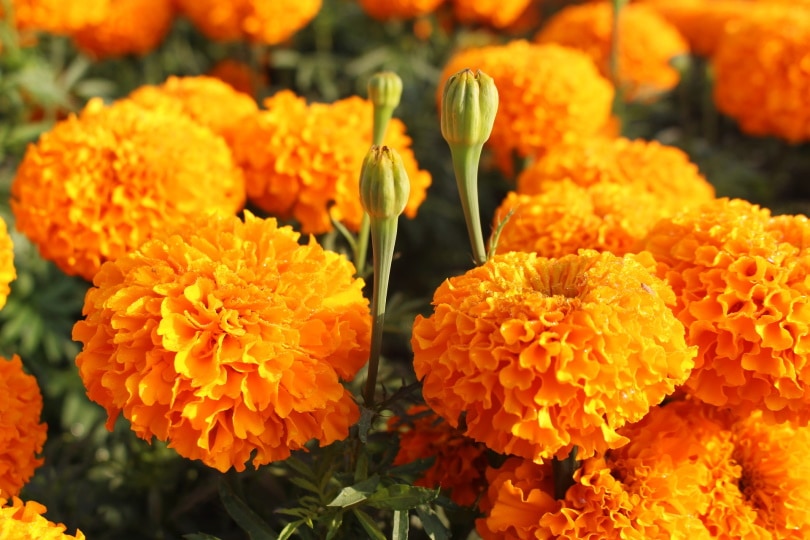
| Scientific Name: | Tagetes |
| Type: | Flowering herbaceous plant |
Marigolds are extremely popular flowers for numerous reasons. They are exceedingly easy to grow and will quickly grow to heights between 2 and 5 feet. They produce thick blooms all summer long. They can be cultivated as annual or perennial plants. Marigolds also attract butterflies while keeping bees away. All of these reasons make marigolds a staple of any flowering garden.
Butterflies like the colors of marigolds which include oranges, reds, and yellows but bees can’t stand the smell. Marigolds have a very pungent and unique odor that is repulsive to bees. Marigolds are also resistant to being eaten by animals like rabbits and deer making them perfect flowers that will not attract any unwanted pests.
3. Geraniums Flower
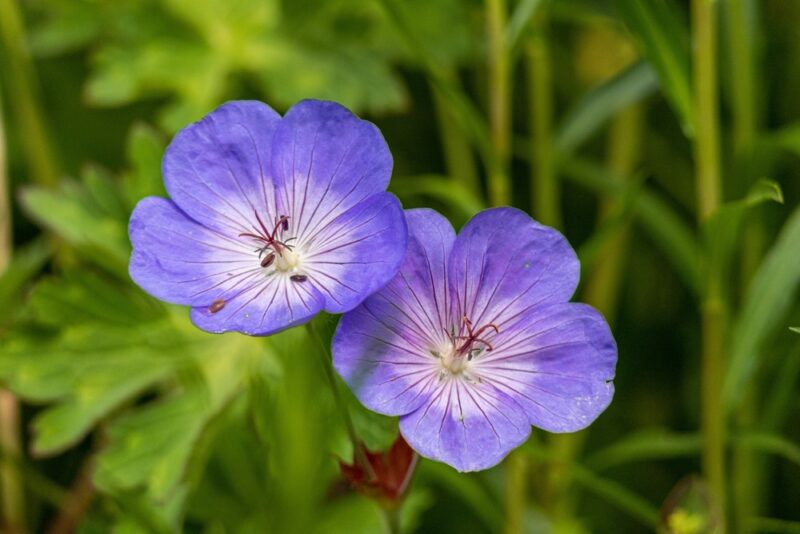
| Scientific Name: | Pelargonium |
| Type: | Annual flower |
Geraniums are very popular flowers that bloom almost constantly from early spring all the way through summer. The long bloom period makes these plants extremely popular for flower gardens. Geraniums really like full sunlight when they are planted outdoors. If you want to keep your geraniums from one year to the next, you can bring them inside during the winter, which requires them to be planted in a pot.
Geraniums make very little pollen which is why they are unattractive to pollinators such as bees. If you are worried about bees getting into your yard, garden, or home, getting red geraniums will add an extra layer of deterrence. Red geraniums have no pollen that can attract bees, and bees will not be able to see the red coloring of the flowers.
4. Cardinal Flower

| Scientific Name: | Lobelia cardinalis |
| Type: | Perennial flower |
Cardinal flowers are named for their bright red cardinal color. Bees do not see red very well, so when they look at a cardinal flower, they do not see anything appealing. Cardinal flowers do not feature any other colors that might attract bees, making them a perfect stealth flower. These flowers can grow very tall, up to four feet, when they are thriving.
The cardinal flower briefly blooms in late summer. They are a part of the bellflower family of plants. They are found from southern Canada all the way through Central America and do best in hardiness zones 3 through 9.
5. Chrysanthemums Flower
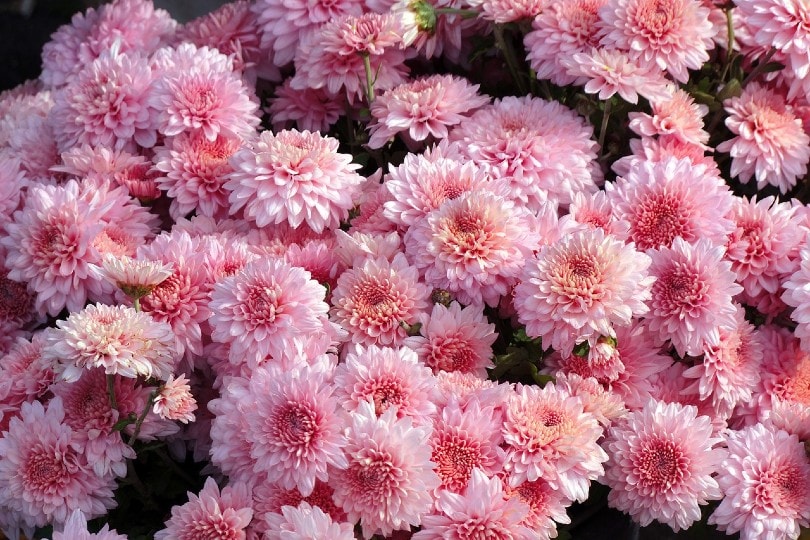
| Scientific Name: | Chrysanthemum |
| Type: | Perennial flower |
Chrysanthemums, also simply called mums, are excellent choices for bee-adverse gardeners. Chrysanthemums produce thick, brightly colored blooms, yet they don’t attract bees. This is a great combination for someone looking for a traditional flower without the threat of bees. The reason why chrysanthemums do not attract bees is that they produce very little pollen or nectar that often attracts the flying insects.
Chrysanthemums are hardy perennial plants in most areas. They can also be planted as annuals in cold climates or planted as indoor plants. There are hundreds of varieties of mums to choose from. Chrysanthemums are fairly low maintenance, but they do require a lot of fertilizer. If you keep your mums fertilized, you will have beautiful, vibrant, and thick flowers to look at without any bees to worry about.
6. Beardtongue Flower

| Scientific Name: | Penstemon |
| Type: | Herbaceous flowering perennials |
Beardtongue, also known as penstemon, is a family of flowers that produces unique blooms that are unappealing to bees. Many beardtongue flowers are enclosed and make it extremely difficult for bees to enter and exit safely, making it nearly impossible for bees to comfortably feed on these flowers. The odd shapes keep the bees at bay, but the color can also play a role. Red beardtongues are doubly offensive to bees.
Beardtongues like full sunlight and can grow multiple feet tall when they are thriving. They bloom in late spring through the summer. These flowers do best in USDA hardiness zones ranging from 3 to 8. If you care for your beardtongue flowers through the winter, they can come back again in the spring without having to replant them, which is nice.
7. Feverfew Flowers
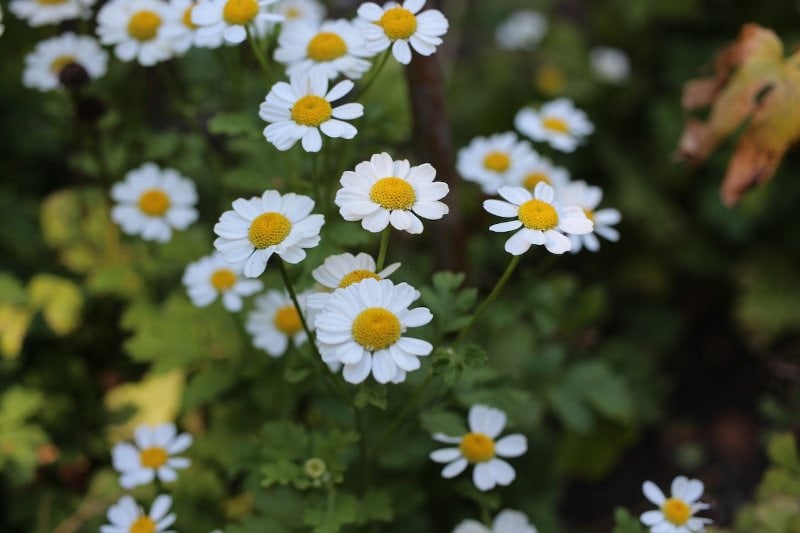
| Scientific Name: | Tanacetum parthenium |
| Type: | Daisy |
Feverfew flowers are so similar to daisies that many people cannot tell them apart. They produce small white flowers with yellow centers, just like a wild daisy. Despite their lovely appearance and growing location, feverfew does not attract bees. That is because the flower gives off a pungent aroma that repels bees. The scent of feverfew is pleasant to humans but stinky to bees which is good if you are looking for a bee-free garden.
It is important to note that the scent given off by feverfew flowers also repels other pollinators. That means if you plant these flowers in your garden, you might accidentally scare away butterflies, moths, and other beneficial insects in addition to bees. Some plants only repel bees, but feverfew will repel more insects than just bees.
8. Red Lily Flower
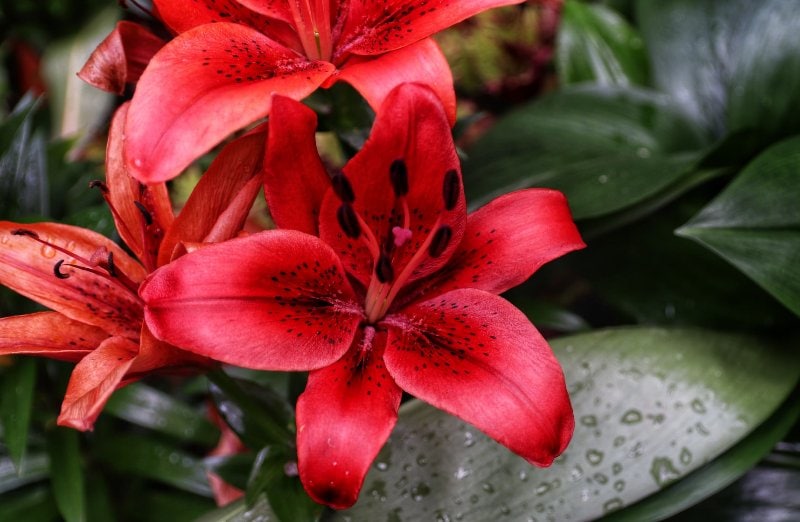
| Scientific Name: | Lilium philadelphicum |
| Type: | Lily |
Red lilies, also known as woody lilies, are unique flowers that are repulsive to bees. The deep red flower looks like an odd black shape to bees. Red lily only produces one large flower with six broad petals. They also do not produce a large number of blooms or a lot of pollen which keeps curious bees disinterested and looking elsewhere.
Red lilies are found throughout the northern half of the United States and are also found clustered in the Pacific Northwest around Vancouver. Be aware that red lilies are extremely toxic to cats. If a cat ingests a red lily, it could be fatal. Red lilies are great at repelling bees, but they are not safe for cat owners, especially for people with cats that have been known to gnaw on plants from time to time.
Learn to Love the Color Red
Bees cannot see the color red. Scientists speculate that since bees physically cannot see red things appear black or gray to them. Black and gray are not appealing colors for bees. If there are no other things that could attract bees, then red things will stay almost invisible to the flying pests. That means if you want to craft a truly bee-free garden, you are going to have to lean heavily into red flowers. There are some red flowers not featured here that might stay off bees’ radar, but these plants are known to be repulsive to bees.
If you want to cut down on the number of bees in your garden, plant red flowers. This is not a foolproof method because some red flowers still produce pollen and scents that bees love, but it will definitely help keep the bees away better than other methods.
Conclusion
You do not have to skimp on amazing flowers to keep your garden free of bees. Do you want roses? Check. How about marigolds? Check. Geraniums? Check. There are tons of options in multiple styles and colors that will keep your garden beautiful without attracting bees. These flowers can grow in a variety of places and in a variety of seasons and are sure to wow. All you have to do is pick your favorite and stop worrying about the bees.
Featured Image Credit: Man Chung, Unsplash
Contents


